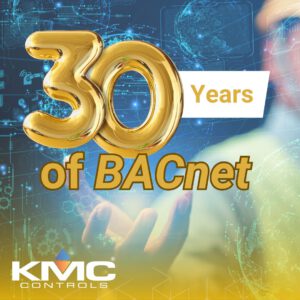Celebrating BACnet’s Legacy
and Looking Ahead to Its Bright Future
This month we can officially celebrate 30 years of BACnet, the revolutionary building automation protocol. This milestone offers a chance to reflect on how this open communication standard has shaped the building automation industry and redefined efficiency, interoperability, and accessibility. Since its adoption as ANSI/ASHRAE Standard 135 in 1995, and later its recognition internationally as ISO Standard 16484-5, BACnet has become an indispensable tool in building management systems worldwide.
 The ASHRAE Journal’s article celebrating BACnet’s 20th anniversary highlighted several key success factors that have allowed it to thrive over decades:
The ASHRAE Journal’s article celebrating BACnet’s 20th anniversary highlighted several key success factors that have allowed it to thrive over decades:
- Tailored for Buildings: Designed specifically with buildings in mind, BACnet initially focused on HVAC but steadily expanded to include lighting, life safety, and even cutting-edge “smart grid” systems.
- Extensibility: It was built to evolve. BACnet has embraced modern technologies such as IPv6 and IoT functionalities while remaining compatible with existing systems.
- Hardware Independence: BACnet’s communication structure avoided dependence on specific hardware, allowing flexible adoption across networks, from Ethernet to wireless.
- Device Scalability: BACnet supports devices of all sizes, from large systems to compact gadgets, fostering innovation at every level.
Beyond its technical strengths, BACnet’s real power lies in the passionate community of professionals who’ve supported and enhanced it over 30 years. Organizations like BACnet International have kept the spirit alive with global events and initiatives, ensuring progress and education around the standard.
Why It Matters Now
For building owners, especially those still running decades-old BACnet automation systems, now is the ideal time to consider updating their setups. New advancements in technology and updated laws, such as tax deductions under Section 179D of the Tax Cuts & Jobs Act, provide significant financial motivation to modernize systems. Through this, building owners can fully deduct the cost of new HVAC or automation systems in the year of purchase.
In addition, due to accelerated or bonus depreciation, established in section 168K of the TJIA, we can expect rates of 40% for 2025 and 20% for 2026. If Congress renews the legislation, it could revert to 100%, similar to what the industry experienced in 2022.
If your organization has felt trapped by outdated systems—be it exorbitant licensing fees or limitations imposed by proprietary vendors—upgrading to modern BACnet solutions offers a way to gain freedom, functionality, and financial efficiency.
BACnet’s 30-year evolution serves as proof of its durability and adaptability. From enabling connected systems to powering the next frontier of smart buildings, BACnet remains at the forefront of building automation technology. Here’s to three decades of progress—and to even brighter innovations ahead!
 Cart
Cart